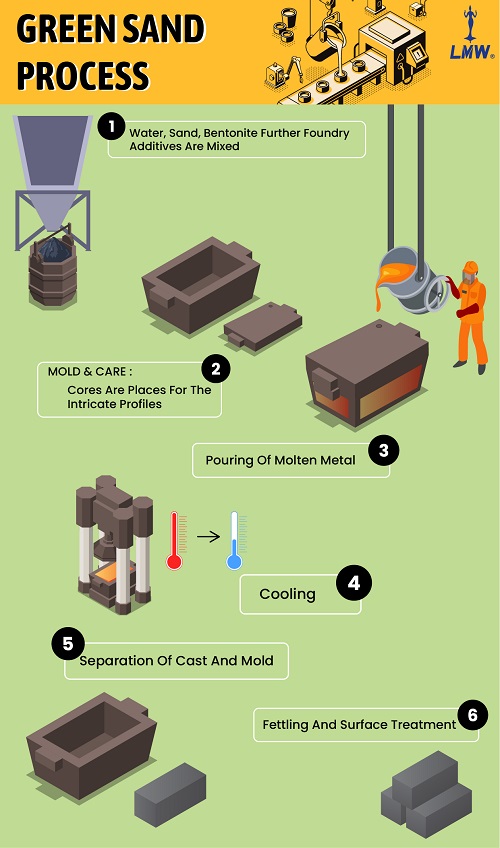August 01, 2022
What is the green sand process?
"Green Sand" denotes the moisture present during the moulding process. The mould is not baked or dried. Instead, raw sand is extracted and processed to give it a consistent distribution of grain sizing. During the moulding process, organic clays are added to bond the grains.
A cloud of coal dust is added to control casting quality during the augmentation of the sand when hot metals are poured into the moulds. Other additives, such as pitch, cellulose, and silica flour, are also used. The additive used depends on the metal cast. Finally, the sand is blended in a mixer, where the water and the additives are blended with the sand.

The sand is then ready to be used to construct a mould. Although there are several methods of moulding, all methods squeeze or compact the sand against a pattern to make an impression of the part to be cast. The patterns are separated from the mould halves, and the mould is then closed. LMW has high-pressure moulding facilities on four different machines, which can make mould ranges up to 1150 X 1350 X 270/270, where we can make large moulds on the floor through green sand. But moulding is done only through automated machines. Pouring is carried out after moulding and allows for solidification. Molten metal is transferred through the ladles, and pouring is automated.
After the metal in the mould has solidified and cooled, the mould is dumped onto a shakeout that separates the castings from the sand. The casting is then separated from the runner system, and the castings shall be processed, and we shall recycle the runner system. Furthermore, sand is being reused, with supplementary sand added and the tests qualified.
Starting with shot blasting, the casting finishing process continues based on demand, the type of application, fit, form, and function.
As part of the green sand process, we will deal with the following ranges.
| Moulding | Material | Wt-range | Moulds | Volumes | Mould box size |
|---|---|---|---|---|---|
| Line of Mfg. | Grade | Kgs. | Nos/Hr | Nos,/Month | in MM |
| SINTO HP | Grey & Ductile | 0.5 to 12 | 200 | 3000 to 200K | 420X520X200/200 |
| ARPA 300 | Grey & Ductile | 0.5 to 15 | 60 | 1K to 2K | 400X520X130/130 |
| ARPA 1300 -I | Grey & Ductile | 50 to 100 | 30 | 200 to 2K | 1150X1350X200/200 |
| ARPA 1300 -II | Grey & Ductile | 50 to 150 | 15 | 100 to 200 | 1920X520X185/185 |
| ARPA 1300 -II | Grey & Ductile | 50 to 150 | 15 | 100 to 200 | 1150X1350X270/270 |


 info@lmwfoundry.com
info@lmwfoundry.com



